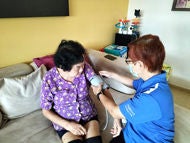What is - Ganglion Cyst
What is a ganglion cyst?
A ganglion cyst is a fluid-filled bump situated beneath the skin, typically found near a joint or around a tendon.

This cyst forms when a small tear occurs in the tissue surrounding a joint or tendon, leading to the formation of a sac. Fluid from this joint thus accumulates in this sac, resulting in a noticeable swelling.
A common health condition, they are mostly seen on the wrist and can also develop on the fingers, ankles and feet. In a Singapore hospital’s study, it was found that more than half (56.9%) of the hand tumours they removed were ganglion cysts (Tang, Rajaratnam, & Desai, 2017).
Symptoms of Ganglion Cyst
What are the symptoms of ganglion cysts?
- Noticeable lump: A common sign is a lump under the skin, usually round or oval-shaped, which can vary in size. It is soft and may become more visible during certain activities.
- Discomfort or pain: While ganglion cysts are generally painless, some people may feel discomfort, especially if the lump puts pressure on nearby areas. Pain can occur when walking or wearing shoes if the cyst is on the foot or ankle.
- Restricted movement: Ganglion cysts near joints can limit normal movement, making it more challenging to move as the cyst enlarges.
- Numbness or tingling sensation: If the cyst is close to a nerve, it may cause numbness or a tingling mild pins-and-needles feeling due to pressure on the nerve.
- Size variation: The cyst can change over time, growing larger or smaller, and in many cases, it may even disappear on its own.
When should you see a doctor for ganglion cysts?
While ganglion cysts are generally harmless and may resolve spontaneously, medical consultation is recommended if the cyst causes pain or restricts mobility.
Ganglion Cyst - How to prevent
How are ganglion cysts prevented?
Ganglion cysts cannot be prevented as the cause is unknown. However, you can reduce your risks by:
- Minimising repetitive strain: Avoid repetitive joint motions or strain that may increase the risk of cyst formation, especially in the wrists and hands.
- Using protective gear: Wear supportive braces or padding if engaging in activities that place stress on joints.
- Practicing good posture: Maintaining proper joint alignment can reduce unnecessary strain, particularly in activities that involve fine motor skills.
- Taking breaks: Regular breaks during activities involving joint use can reduce the risk of cysts forming due to overuse.
Ganglion Cyst - Causes and Risk Factors
What causes ganglion cysts?
The cause of a ganglion cyst is unknown. It typically forms from a joint or the lining of a tendon, resembling a small, fluid-filled sac on a stem. The cyst contains a thick fluid similar to that found in joints or surrounding tendons.
What are the risk factors for ganglion cysts?
- Age: Ganglion cysts are more common in individuals aged 15 to 40.
- Gender: Women are more likely to develop ganglion cysts than men.
- Repetitive strain: Engaging in repetitive motions, especially involving the wrists or fingers, increases the risk.
- Injury history: Previous injuries to the wrist or fingers, including those from sports or accidents, increase the likelihood of cyst formation. The body’s response to injury, such as inflammation and tissue repair, may facilitate cyst development.
- Chronic inflammatory conditions: Conditions like arthritis, which cause continuous inflammation in joints or tendons, can trigger the formation of cysts as part of the body’s response to inflammation.
Diagnosis of Ganglion Cyst
How are ganglion cysts diagnosed?
The diagnosis of ganglion cysts may involve:
- Physical examination: Your doctor will examine the lump, inquire about your medical history and ask about the duration and any symptoms associated with the lump.
- Imaging tests: For a comprehensive assessment, imaging such as X-rays or ultrasound may be recommended.
- X-rays: Used to rule out more serious musculoskeletal issues, such as arthritis.
- MRI: Though not commonly used, MRI can help exclude other tumours and provide insight into the cyst's consistency.
- Ultrasound: Distinguishes cysts from blood vessel abnormalities and helps doctors avoid puncturing an artery during cyst aspiration.
- Transillumination: A light is shone through the affected area to differentiate between a solid tumour and a fluid-filled cyst, such as a ganglion cyst. The way the light passes through can provide valuable information on the cyst's composition.
- Aspiration of cyst fluid: If the diagnosis remains uncertain, your doctor may aspirate fluid from the cyst using a thin needle. The fluid can be analysed to confirm the diagnosis and rule out other causes for the lump.
Treatment for Ganglion Cyst
How are ganglion cysts treated?
Treatment for ganglion cysts may involve:
- Observation: If the cyst is not causing pain, discomfort or interfering with daily activities, observation is often a viable option.
- Lifestyle modifications: If you experience pain or limited mobility, your doctor may suggest lifestyle adjustments, such as avoiding repetitive hand or wrist movements, using a wrist brace or adjusting footwear if the cyst is on the foot or ankle.
- Medical intervention: In cases where the cyst causes significant discomfort or affects quality of life, medical intervention may be considered. Aspiration, which involves draining the cyst’s fluid, can offer relief, though it may not prevent recurrence.
- Surgical excision: If other treatments are ineffective or the cyst reoccurs, surgical removal is the gold standard treatment. There is still a chance of recurrence even after successful surgery.
FAQs on Ganglion Cyst
No, ganglion cysts are almost always noncancerous (benign). They are fluid-filled sacs that typically arise from joints or tendons.
No, ganglion cysts do not always cause symptoms. Many people may have them without experiencing any pain or discomfort. Symptoms, when present, can include pain, discomfort or limitations in joint movement.
It is challenging to prevent ganglion cysts entirely, as their exact cause is unclear. However, avoiding repetitive stress on joints, protecting against injuries and addressing joint inflammation promptly may reduce the risk.
Trying to pop or drain a ganglion cyst at home is not advisable. This can lead to infection or injury and may not effectively treat the cyst. A healthcare professional should perform aspiration or drainage in a sterile environment to minimise risks and ensure proper care.
References
Gregush, R. E., & Habusta, S. F. (2023). Ganglion Cyst. In StatPearls. StatPearls Publishing. https://www.ncbi.nlm.nih.gov/books/NBK470168/
Tang, Z., Rajaratnam, V., & Desai, V. (2017). Incidence and anatomical distribution of hand tumours: A Singapore study. Singapore Medical Journal, 58(12), 714–716. https://doi.org/10.11622/smedj.2016147
Ganglion cysts. Symptoms, Diagnosis and Treatment | Nationwide Children’s Hospital. (n.d.). https://www.nationwidechildrens.org/conditions/ganglion-cysts
Ganglion cyst of the wrist and hand - orthoinfo - aaos. OrthoInfo. (n.d.). https://orthoinfo.aaos.org/en/diseases--conditions/ganglion-cyst-of-the-wrist-and-hand/
Feger, J. (2020). Ganglion cysts of the hand and wrist. Radiopaedia.Org. https://doi.org/10.53347/rid-84020
The information provided is not intended as medical advice. Terms of use. Information provided by SingHealth.
Get to know our doctors at SingHealth Hospitals in Singapore.
Get to know our doctors at SingHealth Hospitals in Singapore. here.





















